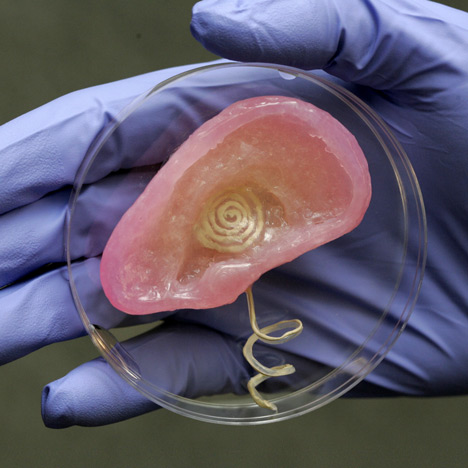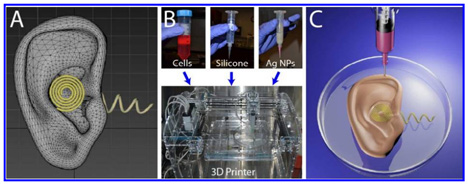
Scientists 3D-print bionic ear that hears beyond human range
News: nanotechnology scientists at an American university have 3D-printed a bionic ear that can hear radio frequencies beyond a human's normal range.
The ear is designed to integrate electronics with biology and create a flexible and fleshy alternative to mechanical prosthetics.
"This concept of 3D printing living cells together with electronic components and growing them into functional organs represents a new direction in merging electronics with biological systems," said the scientists in their report, published in the journal Nano Letters.
The Princeton University team printed the ear from hydrogel – a material used as scaffolding in tissue engineering – using the commercially available Fab@Home 3D printer.
The hydrogel was infused with cells from a calf and intertwined with a polymer containing silver nanoparticles, which conduct radio frequencies.
The calf cells then matured into cartilage and hardened around a coil antenna, seen in the middle of the ear.

images of the functional materials (bottom) 3D printer; C: illustration of bionic ear
When tested, the bionic ear was found to receive signals across an extended frequency spectrum of 1 MHz to 5 GHz, far beyond the normal human range of 20 Hz to 20 KHz.
The team also created a complementary left ear and used a piece of music by Beethoven to successfully test the pair's ability to hear in stereo.
At present the ear can only receive radio waves, but the scientists believe it would be possible to expand its hearing with other materials, such as pressure-sensitive sensors that register acoustic sounds.
Medical applications for 3D printing are becoming increasingly commonplace, as bioprinting expert Michael Renard recently told Dezeen in an interview for Print Shift, our one-off, print-on-demand magazine about this emerging technology.
"We're working with small pieces of tissue at the moment - a small piece of blood vessel or liver," he said. "Once you have the cells ready, we can print something in a few hours." Read the full interview with Renard.
Other 3D printing projects we've reported on lately include prototypes of 3D-printed burgers and pasta and designer Ron Arad's single-piece 3D-printed spectacles – see all 3D printing.
Top photograph by Frank Wojciechowski.